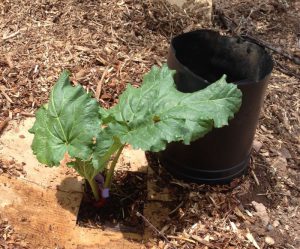Rhubarb has been brought to my attention several times in recent months. This spring I noticed a rhubarb plant at the local garden center:

A few weeks later I saw stalks of rhubarb at the farmer’s market, so I picked up a bundle. Last week, while perusing through the Cayce readings about kidney problems, I ran across a reference to using “pie plant” (rhubarb) and other fruits/plants as mild laxatives:
21. (Q) What should be done for constipation?
(A) Use the irrigations rather than too much of cathartics.When there are laxatives taken, use those rather that are of the vegetable nature; or a Senna compound, or Figs, Raisins and the Pie Plant. Any or all of these at various times or in various manners are most beneficial. These are a portion of the NECESSITIES for the body to keep in the physical forces. [1446-3 F 43]
In the readings, the name ‘rhubarb’ seems to have been used more for the plant used as medicine, while the name ‘pie plant’ seems to have been used for the stalks when eaten as food.
(Q) What particular diet at this time?
(A) A general diet that includes those active forces that have a tendency for laxative reaction; as prunes, figs, stewed raisins – all of those activities that include such. The pie plant or rhubarb, those of such natures that tend to make for not merely weight but an activity to the mucous membranes to the LOWER intestinal system. [633-6]
Some people eat their rhubarb uncooked, but Mr. Cayce said the laxative foods are commonly stewed (cooked with sugar):
19. Mornings – citrus fruit juices or stewed fruits; preferably prunes and the pie plant (rhubarb, you see), and when this is stewed the sugar added should preferably be the heavy brown sugar or saccharin or beet sugar. [367-1 M 14]
Rhubarb leaves are poisonous, but the stalks and roots are good sources of emodin, one of the active ingredients produced by the plant. Syrup of rhubarb was probably commonly available when the readings were being given, but today this has to be searched out.
I’ve seen rhubarb stalks in some grocery stores. Many stores carry frozen rhubarb, so look for that too.
The Cayce Herbal entry for Rhubarb has several more quotes from the readings.
Finally, this academic paper about the history of rhubarb is interesting, if you’re into that sort of thing:
Rhubarb was grown and used throughout China for thousands of years. It then found its way to St Petersburg where the Romanovs developed a flourishing trade in the plant to the rest of Europe. James Mounsey, a physician to the Tsar, brought back seeds from Russia to Scotland at considerable risk to himself. He passed some of the seeds to Alexander Dick and John Hope. Both these physicians then grew rhubarb at Prestonfield and the Botanic Garden (both in Edinburgh), respectively. Eventually rhubarb, in the form of Gregory’s powder, became a common and popular medicine throughout the UK.